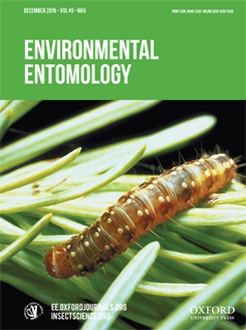Insect populations are affected by density-dependent and density-independent factors, and knowing how these factors affect long-term population growth is critical to pest management. In this study, we experimentally manipulated densities of the hemlock woolly adelgid on eastern and western hemlock trees in the western USA to evaluate the effects of density and host species on hemlock woolly adelgid crawler colonization. We then followed development of hemlock woolly adelgid on each hemlock species. Settlement of crawlers was strongly density-dependent and consistent between host species. In addition, a period of hot days that coincided with the settlement of hemlock woolly adelgid crawlers put our experimental and naturally occurring populations into diapause during April. Diapause resulted in one generation that yr in our experimental population. Analyses of long-term air temperature records indicated that diapause-inducing temperatures in April similar to those observed in our experiment have occurred rarely since 1909 and the frequency of these events has not changed over time. Prior work suggests that hemlock woolly adelgid completes two generations per yr in the western USA with a diapause occurring in the summer. This typical life history reflects the long-term influence of regional average seasonal temperature patterns on development and the timing of diapause-inducing temperatures. However, the timing of unseasonal weather, such as the hot days observed in our experiment, occasionally changes life history trajectories from this normal pattern. Our results show that density-dependent and density-independent factors have strong effects on generational mortality and life history of hemlock woolly adelgid that are important to its population dynamics and management.
BioOne.org will be down briefly for maintenance on 17 December 2024 between 18:00-22:00 Pacific Time US. We apologize for any inconvenience.
How to translate text using browser tools
30 September 2016
Density-Dependent Recruitment and Diapause in the Spring-Feeding Generation of Hemlock Woolly Adelgid (Hemiptera: Adelgidae) in Western North America
Aaron S. Weed,
Joseph S. Elkinton,
Nina K. Lany
ACCESS THE FULL ARTICLE
It is not available for individual sale.
This article is only available to subscribers.
It is not available for individual sale.
It is not available for individual sale.

Environmental Entomology
Vol. 45 • No. 6
December 2016
Vol. 45 • No. 6
December 2016
Adelges
diapause
life history
survival
Tsuga




